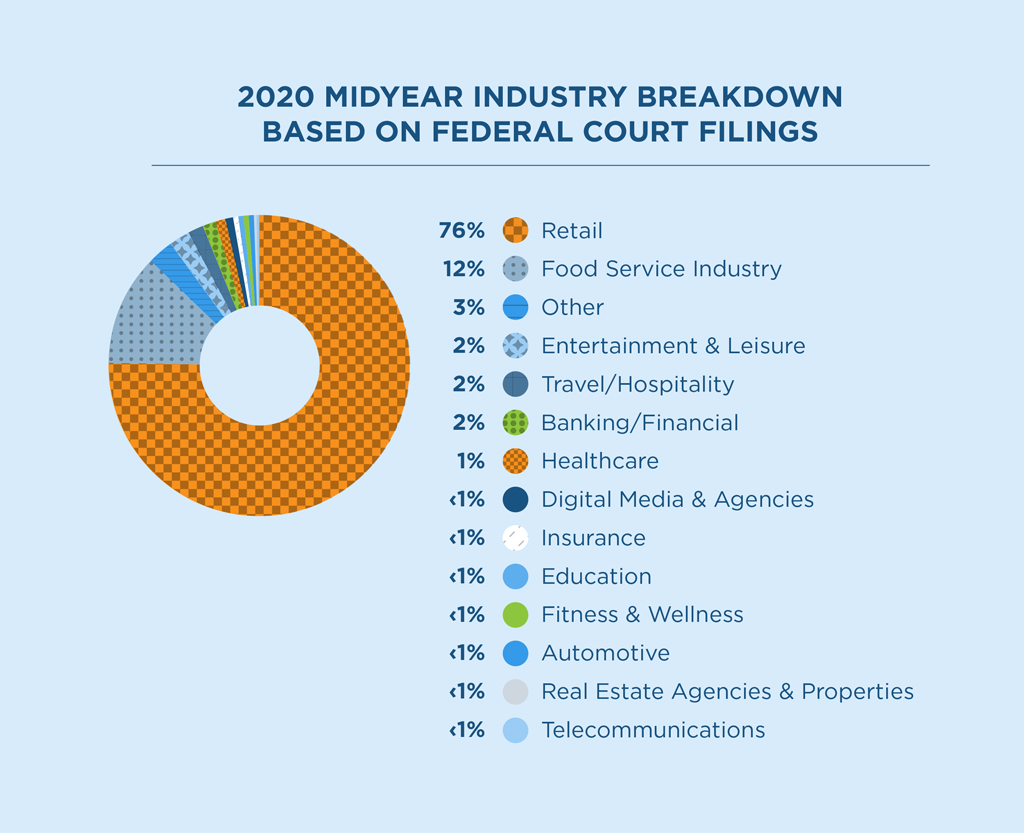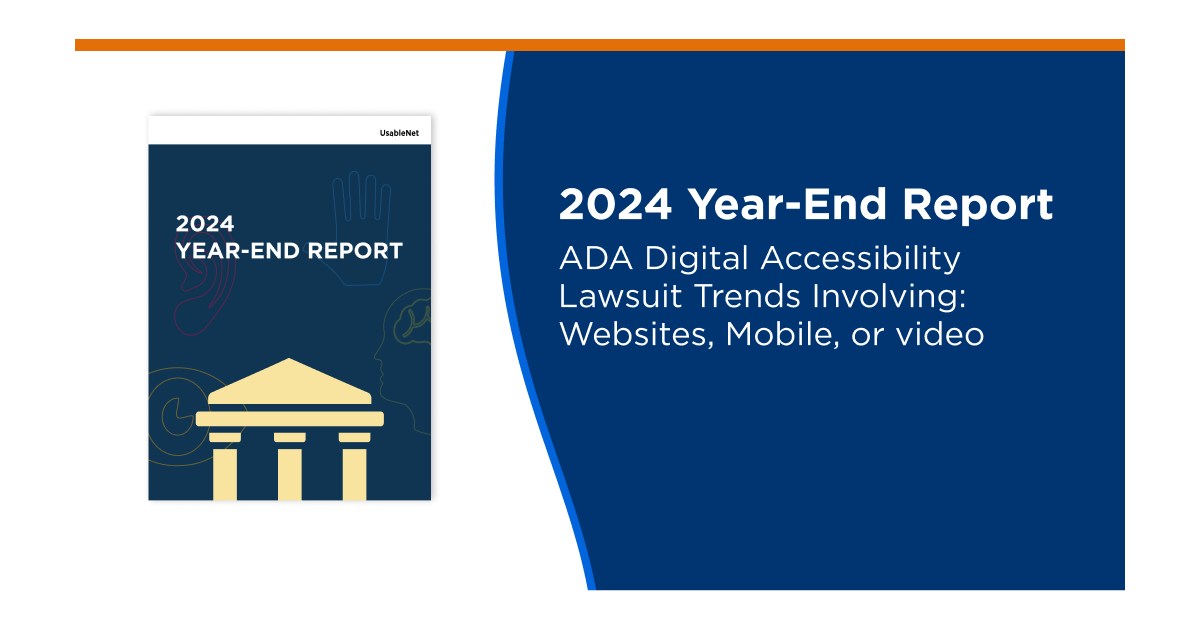Twice a year, UsableNet releases a lawsuit report to help companies plan and prioritize their digital accessibility initiatives. On July 2, we released our 2020 midyear report. The highlights of this report include the emergence of California Federal and State Court filings, the shift from 2.0 to 2.1, the most targeted industries, and the growing trend of lawsuits being filed against websites that use accessibility widgets and overlays.
In this blog post, I'll review some of the report's main takeaways and share what factors may putting your organization at risk for a lawsuit.
For our 2020 Midyear report, the UsableNet research team monitors all Americans with Disabilities (ADA) lawsuits filed in federal court for cases related to website and app accessibility. This year for the first time we also included data for lawsuits filed in California State Court under the Unruh Civil Rights Act.

More Legal Action
State-filed lawsuits and demand letters are on the rise and more than make up for a slight drop off of cases in Federal Court during lock-down. When we combined the numbers from State Courts, Federal Court, and reports of claim letters, we found that plaintiffs are taking more legal action in 2020 than in years past.
In California, accessibility lawsuits surged due to lawsuits based on the Unruh Civil Rights Act. If you are doing business in California, you face double the risk for receiving a lawsuit. 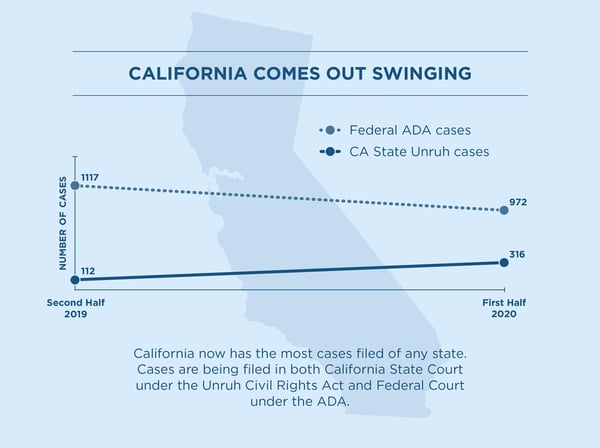
The Coronavirus Pause is Over
Coronavirus forced people all over the globe to stay home. Accommodations requested for years by people with disabilities became accommodations that everyone needed.
While businesses and whole industries closed during lock-down, the same can’t be said for plaintiff law firms. New digital accessibility lawsuits continued, albeit at much lower levels, in March. By the end of April, the rate of ADA-based web and app lawsuits filed in federal court returned to its previous record-breaking pace. 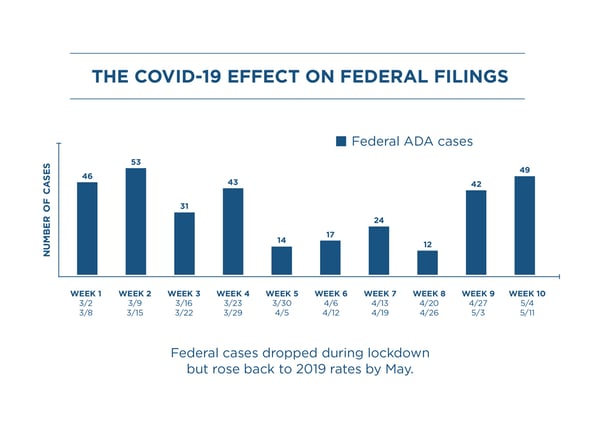
More Mobile App Lawsuits
Everyone relies on mobile devices and so lawsuits for mobile apps are increasing. In addition, as part of the Domino's pizza accessibility lawsuit last year, the court ruled that the ADA also applied to the Domino's app, not just the website.
In the past, the DOJ indicated that apps as well as websites are subject to the ADA. The majority of app cases are against companies that had received a website accessibility lawsuit in the past. 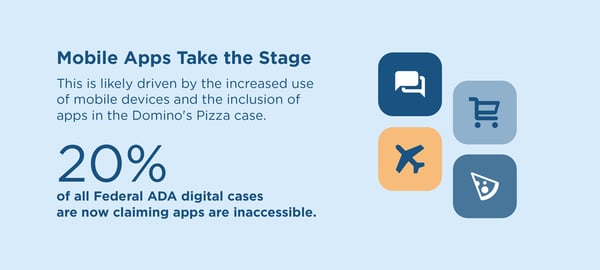
A11y Widgets and Overlays Will not stop lawsuits
Widgets and overlay vendors claim that their technology will protect clients from lawsuits. However, our research team found nearly 100 companies that were sued in the first six months of 2020 that also had an overlay or an accessibility widget enabled on their website.
For our midyear report, the UsableNet team reviews individual dockets for each case filed in federal court under the ADA. In some of these dockets reviewed, our research team found that features that widget and overlay solutions add to a client website were mentioned as adding to the inequality of the experience, not removing it.
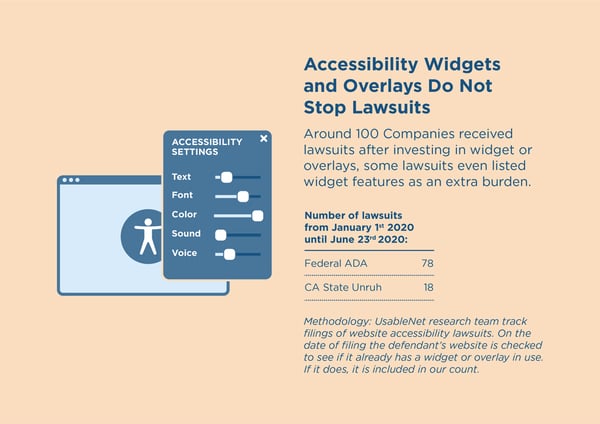
WCAG 2.1 AA is the New Standard
The Accessibility Guidelines Working Group recommends that sites adopt WCAG 2.1 as their new conformance target. This year, legal claims more frequently cited WCAG 2.1 AA as the measure of accessibility and the requested standard for remediation. WCAG 2.1 builds on WCAG 2.0, meaning that web pages that are 2.0 compliant may need more testing and work to meet the 12 success criteria that were added in WCAG 2.1 AA. 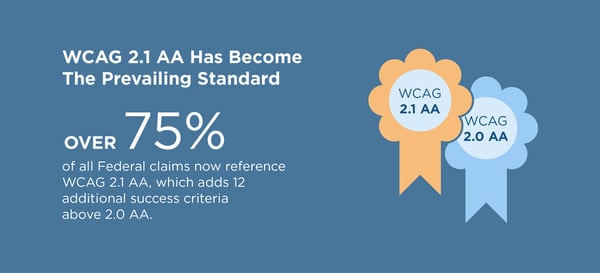
Retail faces the most litigation
The general spread of industries affected by ADA-based Web lawsuits has not changed much over the last two years. Retail tops the list. Retailer websites are easy to visit quickly, public-facing, and technically complex. Often retailers have apps or websites that require frequent updates and code changes. All of these factors add to the risk of ADA noncompliance for any company, regardless of industry. Retailers received more ADA website lawsuits than any other industry so far in 2020.
New Players on the Plaintiff Side
Historically, we've found a high concentration of cases brought by relatively few plaintiff firms. This year, with more lawsuits in California under the Unruh Act and more lawsuits for mobile apps, we added a few new plaintiff firms to our top ten.
What puts you at risk for an ADA Website lawsuit?
After 20 years in the accessibility industry, this is one of the questions I get asked the most. Based on our data, certain factors do put you at greater risk.
If you are in in the retail business you are a top target. If you are in California or selling to customers in California, you have double the exposure. Do you have multiple websites or an app? In 2020, we're seeing that both your website and apps are subject to in-accessible legal claims. Have you invested in low cost accessibility widgets or overlays? You're not alone but you also aren't protected from lawsuits. Companies that invested in widgets and overlays are being sued for non compliance with the ADA.
But what really puts you at risk? Doing nothing. You're at risk for a lawsuit if you have a website or app that can't be used by everyone. Don't be afraid to get started.
Create your Accessibility Plan
The first half of the year brought many changes including a renewed sense of urgency and importance for digital inclusion. In 2020, new plaintiffs, different digital experiences and expanded standards will mean more legal action.
The best and most important action a company can take is to establish an accessibility plan, commit to it with resources and start on the path to digital inclusion for all. If you are overwhelmed, the right accessibility partner can guide you.
Our midyear report is here to help as you plan and prioritize your digital accessibility initiative. 

